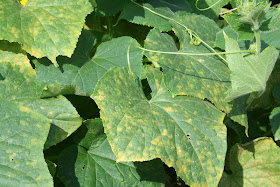MG Gary Ankney talked about perennial vegetables today with an emphasis on asparagus, horseradish and rhubarb. Gary also shared his harvesting tidbit of always having half gallon plastic jugs, with the tops halfway cut away, available on his garden fence for those times when he finds fruit available to harvest. He adds a clip on top which he can attach to his belt to leave his hands free.
Bill Dorman shared with us his ripe 1 lb Dorman Tennessee Oxheart tomato and a branch of edamame - soybeans that grow in clusters on bushy branches.
We harvested corn, beans, tomatoes, squash, basil, and cucumbers.
Our pole beans on the tepee support look impressive, and some cucumbers have started to climb, as well.
Cucumbers showing signs of powdery mildew.

Gary uses a combination of 1 part milk and 10 parts water sprayed on the leaves to manage the disease.
In the no till garden we added some
We again had a good harvest.
We also found that some of our tomato supports were not tall nor strong enough for our plants. We had to add additional supports and tie fallen plants to them.
There is a technique of tying vines to supports by wrapping the string around the supports a couple of times, then around the tomato plant. This supports the plant without breaking the vines.
One new bit of knowledge that we gained when harvesting corn was the presence of huitlacoche, (also spelled cuitlacoche) an edible fungus, Ustilago maydis, that grows on corn and is considered a delicacy in Mexico. Some varieties are more susceptible than others.
It's commonly called corn smut here in the U.S. and managed as an undesirable infection but is also gaining in popularity among foodies.
In Mexico, however, farmers smile when they see a smut infestation because the fungus, considered a delicacy, fetches a higher price than the corn. In an attempt to gain mass acceptance north of the border, foodies have re-branded it the “maize mushroom,” though it’s not a true mushroom. “Mexican truffle” might seem more accurate, because truffles aren’t true mushrooms either, but they belong to a completely different phylum, the Ascomycota. The ancient Aztecs, who believed it possessed mystical, even aphrodisiac powers, simply called it huitlacoche (wee-tlah-KOH-cheh) variously translated as “raven excrement” or just plain “black sh*t.”
 |
| 15-17 days after innoculation and ready to harvest Picture courtesy of Purdue University |









No comments:
Post a Comment